Brief History of the
Mexican Bank Note
Due to the huge mining wealth of the New Spain Viceroyalty, during the three hundred years of colonial rule in Mexico, currency consisted only of gold, silver and, in a smaller quantity, copper coins. Paper money did not appear until the 19th century in Mexico, after the independence was reached.
Background.
The political and social order of the New Spain Viceroyalty was disturbed by the Independence Revolt that started in 1810, resulting in a deep economic crisis due to the abandonment of mines (the economy's pillar) and capitals fly back to the Iberian Peninsula. Thus, the lack of currency was another problem of the torn colony. Several emergency necessity mintings and the first paper money appeared in Mexico; among these, in 1813, curious half a real pieces of orange cardboard appeared in San Miguel el Grande, Guanajuato, the issuers of which are unknown. Another background to the Mexican banknote is found in the late 18th century, at the former Spanish colony Louisiana, where banknotes in several denominations were issued.
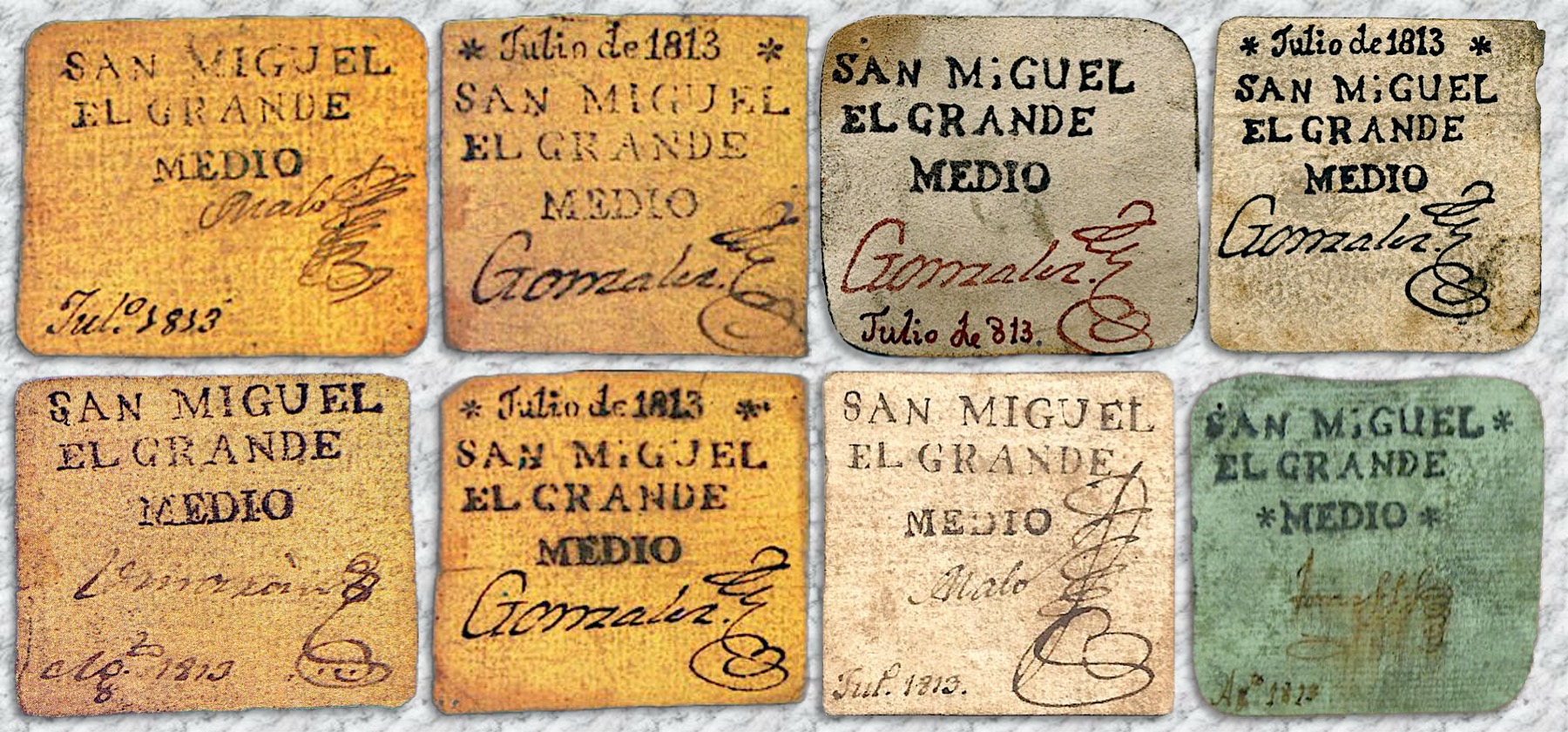
Pieces of cardboard issued in 1813
The First Empire Banknote.
After the consummation of the Independence in 1821, Mexico adopted a monarchic government leaded by the criollo Agustin de Iturbide, who faced a terrible economic penury resulting from the eleven year war. In order to solve this situation, Iturbide tried several measures: he gave considerable support to mining production, resorted to mandatory loans, wage deductions for both civil and military personnel and tax increases.
Nevertheless, the results of such actions were not as expected to afford the growing Court's expenditures and proved even counterproductive by raising the Emperor's discredit. As as drastic resort, paper money was issued (December 20th, 1822). These notes, the first official issue in Mexico, are also considered the first provisional necessity banknotes in this country. These pieces are printed on a single face, on an almost square shaped white paper, bear the legend IMPERIO MEXICANO (MEXICAN EMPIRE), and were issued in 1, 2, and 10 peso denominations.
The fate of the banknotes was not different from other actions taken by the imperial government. They were never accepted by the public, that was used to handling coins; furthermore, these banknotes were suitable to mishandling among officials and payers, and contributed to the government discredit. Although many reasons caused the quick overthrown of Iturbide's government, the failure of his treasury and monetary policy was vital.
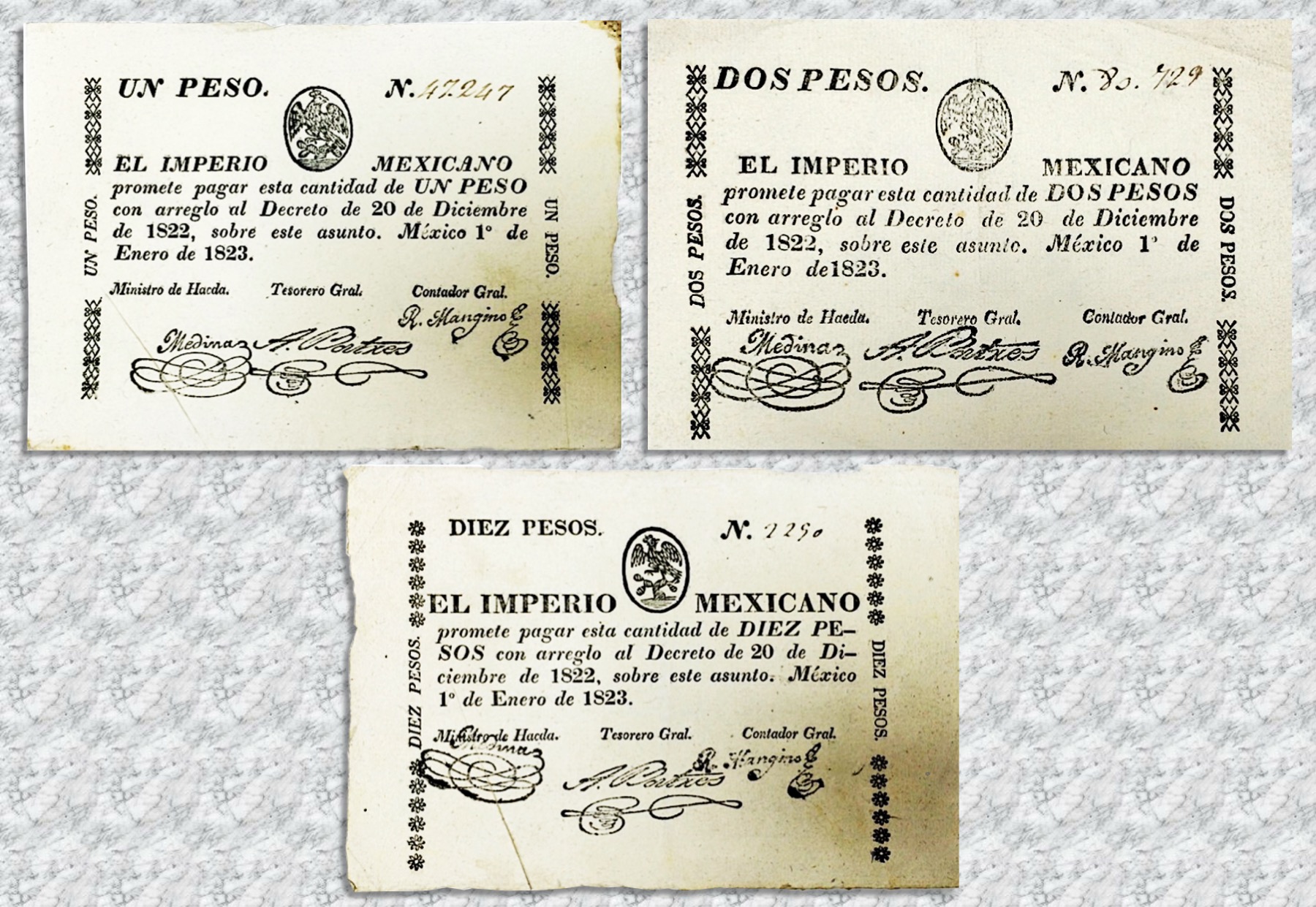
First official Mexican banknote issue
The 1823 Republican Banknote.
In 1823, Mexico became a Federal Republic. The new government tried to correct the treasury mistakes made by the Empire and to restore public trust in the government's financial management. Therefore, among other actions taken, mandatory loans stopped and the imperial banknote was withdrawn from circulation.
Nevertheless, the serious treasury penury was not solved and paper money was issued once more to finance the state. This time, in order to halt the popular reject to this exchange medium, it was printed on cancelled papal bulls, which were expected to be accepted due to the religiousness of the Mexican people. The result was not different from the obtained by Iturbide: banknotes were not accepted by the public and soon they had to be withdrawn from circulation.

Republican Banknote (front and back)
Private Issuing Banks.
Many decades after the monetary failures by the Empire and the Republic, paper money was finally accepted in Mexico.
It was not until 1864, during the Empire of Maximilian of Habsburg, when the project of issuing banknotes was resumed, but now under different conditions: the party responsible for the issue would be a private bank and the banknotes would be accepted voluntarily.
In January 1864, at the request of a group of European bankers headed by Michel Heine, the first series of banknotes bearing the title Banco de México were printed, but it is unlikely that any banknotes ever actually circulated.
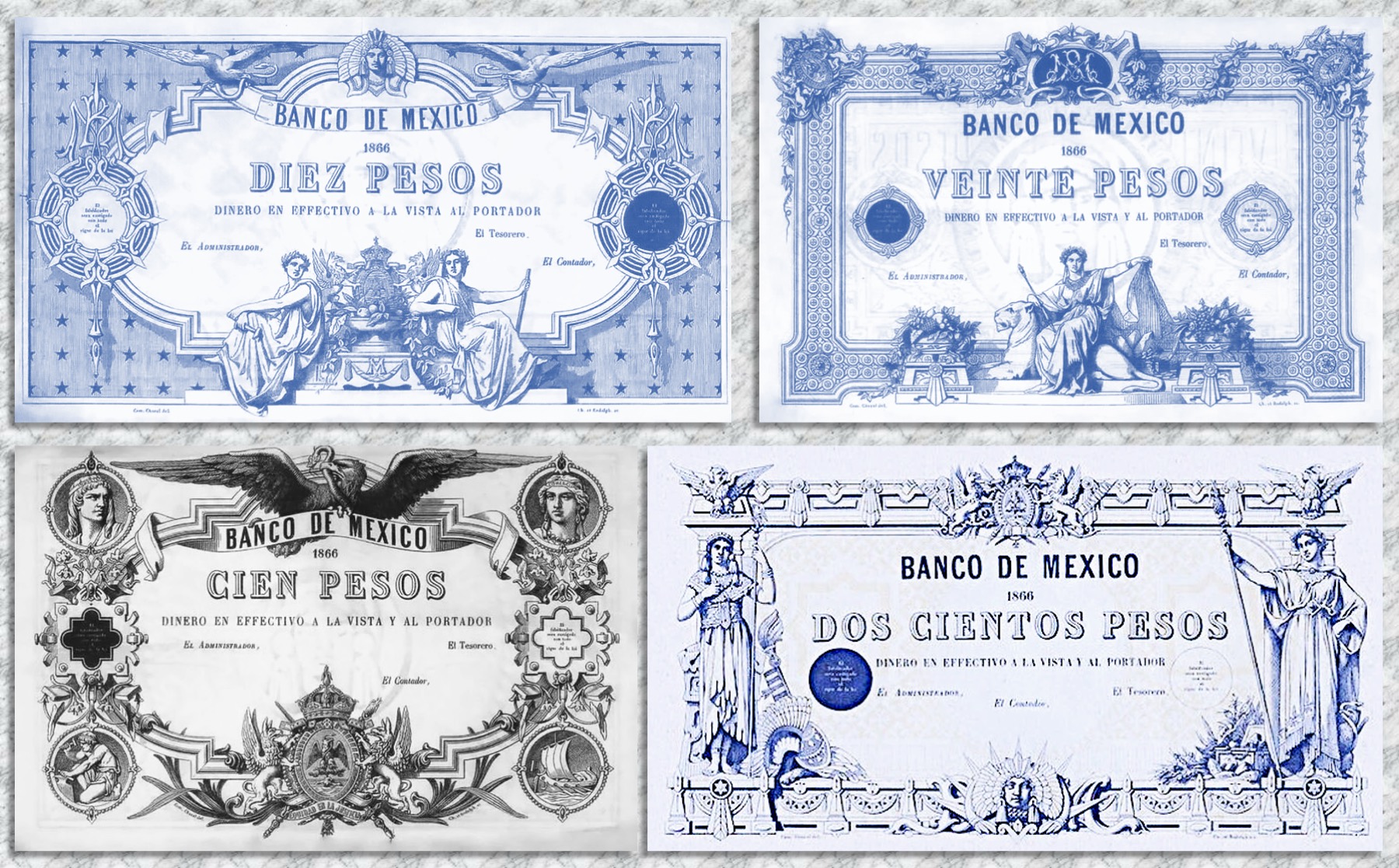
Banknotes issued by the Bank of Mexico ![]()
In February 1864, two Britons, William Newbold and Robert Geddes, were commissioned to form a bank of issue, deposit and discount under the name Bank of Mexico. In April of the following year, the name was changed to Bank of London, Mexico and South America, since it would also operate in Peru and Chile in addition to Mexico. On this occasion, the banknote was a great success; in some circles, it was even preferred to metallic coins.
In 1867, upon coming to power, Benito Juarez abolished the laws in force during the French intervention, in order to nullify all acts of the Empire. Aware of the constructive work of the Bank of London, Mexico and South America, Juarez allowed it to continue its operations and grow without opposition.
The bank was fickle in its choice of printers, using both British companies and the American Bank Note Company before finally settling on the latter. The chronology seems to have been:
- the first issue in 1865 to 1867, probably by Perkins Bacon and Company,
- the American Bank Note Company from August 1866 to July 1883, for higher denominations from $20 to $1,000,
- Thomas de la Rue in 1870, for $5 and $10 notes,
- Bradbury Wilkinson from 1878 to 1882, for $5 and $10 notes,
- another Bradbury Wilkinson in 1887, for denominations from $5 to $500, and finally
- the American Bank Note Company from September 1889 to March 1914.
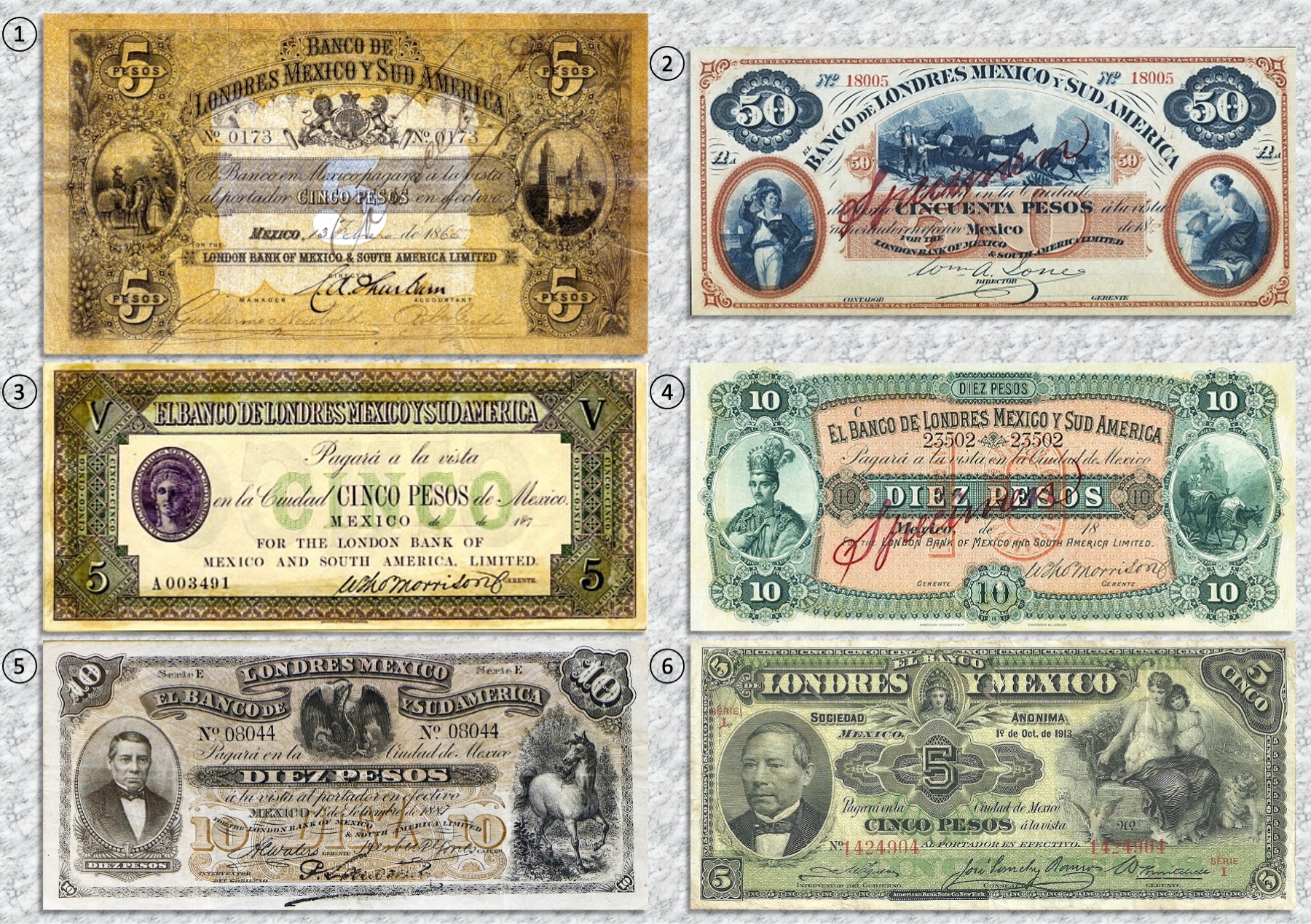
Banknotes issued by the Bank of London, Mexico and South Americaa ![]()
With the fall of the Empire and the Republican Restoration, the issuance of banknotes found favorable conditions, especially during the long government of General Porfirio Díaz (1877-1911). The reestablishment of diplomatic and commercial relations between Mexico, France and Great Britain in 1880, interrupted in 1862 during the Second French intervention in Mexico, and the resumption of payment of the external debt to European creditors, allowed Mexico to attract a greater flow of foreign direct investment in its banking sector, particularly from France.
The government of President Manuel González Flores proposed the creation of a bank with European capital and on August 16, 1881 granted the concession allowing the establishment of the Mexican National Bank with deposit, discount and issue powers. The Mexican National Bank began operating to the public on February 23, 1882.
From its inception, the bank was authorized to open branches and agencies throughout the country, it was granted extensive tax exemptions and, since it held a monopoly on issuing paper money, its banknotes were the only ones valid for paying taxes, so it ultimately became the Mexican government's banking institution.

Banknotes issued by the Mexican National Bank ![]()
In view of the prerogatives granted to the Mexican National Bank for its operation, a group of merchants of Spanish origin who controlled a large part of the wholesale business of textiles, tobacco and food products in Mexico City, called a meeting on August 29, 1881 for the establishment of a national bank that would compete with the Mexican National Bank "e;in order to prevent the prosperity of other nations from increasing."e; The Mexican Mercantile Bank was established on that date; it was authorized to operate on February 18, 1882 and began operations on March 27, 1882.
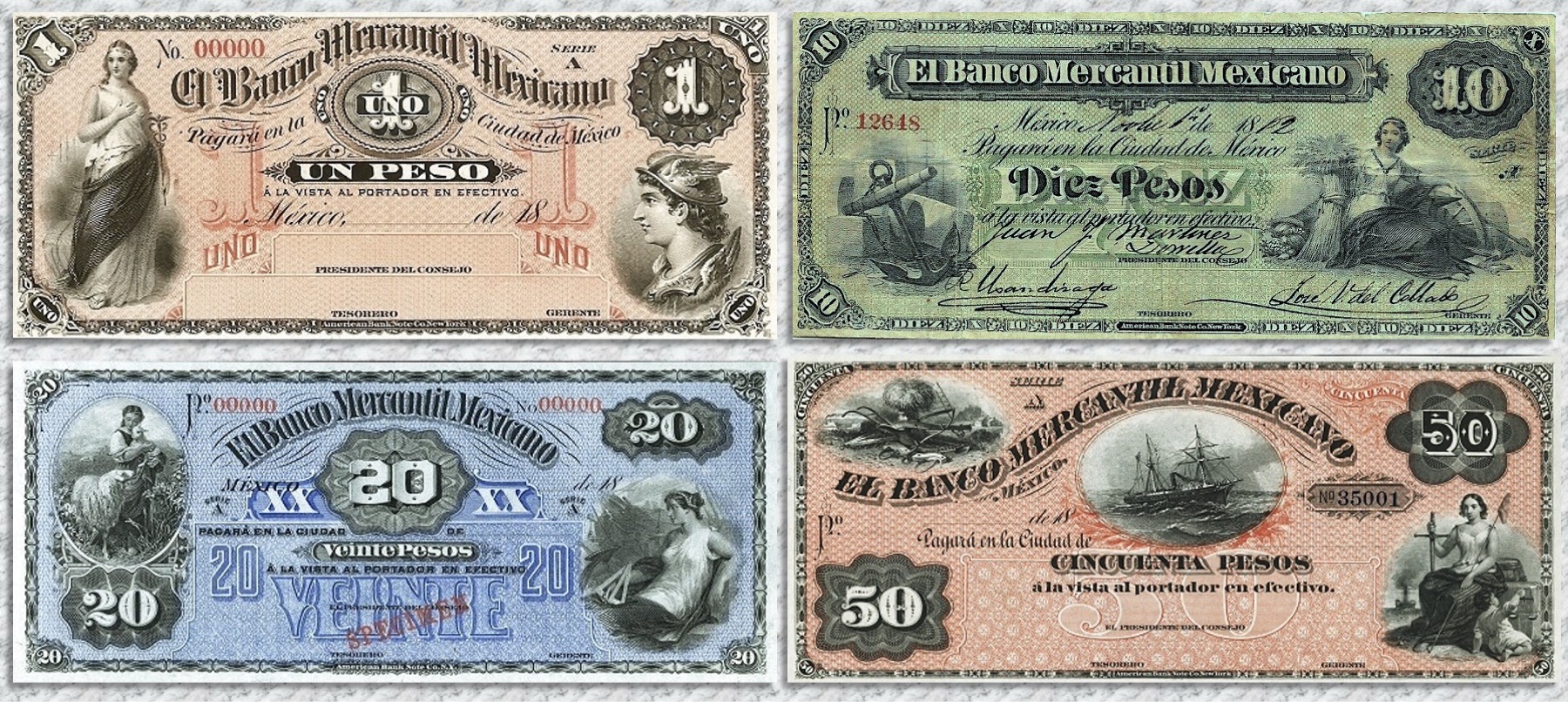
Banknotes issued by the Mexican Mercantile Bank ![]()
The National Bank of Mexico was founded on June 2, 1884 as a result of the merger between the Mexican National Bank and the Mexican Mercantile Bank carried out by the board members of both institutions. In accordance with the Law of Credit Institutions of 1897, a firm, functional and organized banking system was created in which each state of the Republic had at least one private bank issuing bank, in addition to the National Bank of Mexico with presence throughout the Republic and the Bank of London and Mexico (formerly called the Bank of London, Mexico and South America), whose charter was ratified. The banknotes issued by these two institutions circulated nationally, sometimes revalidated in the different states.
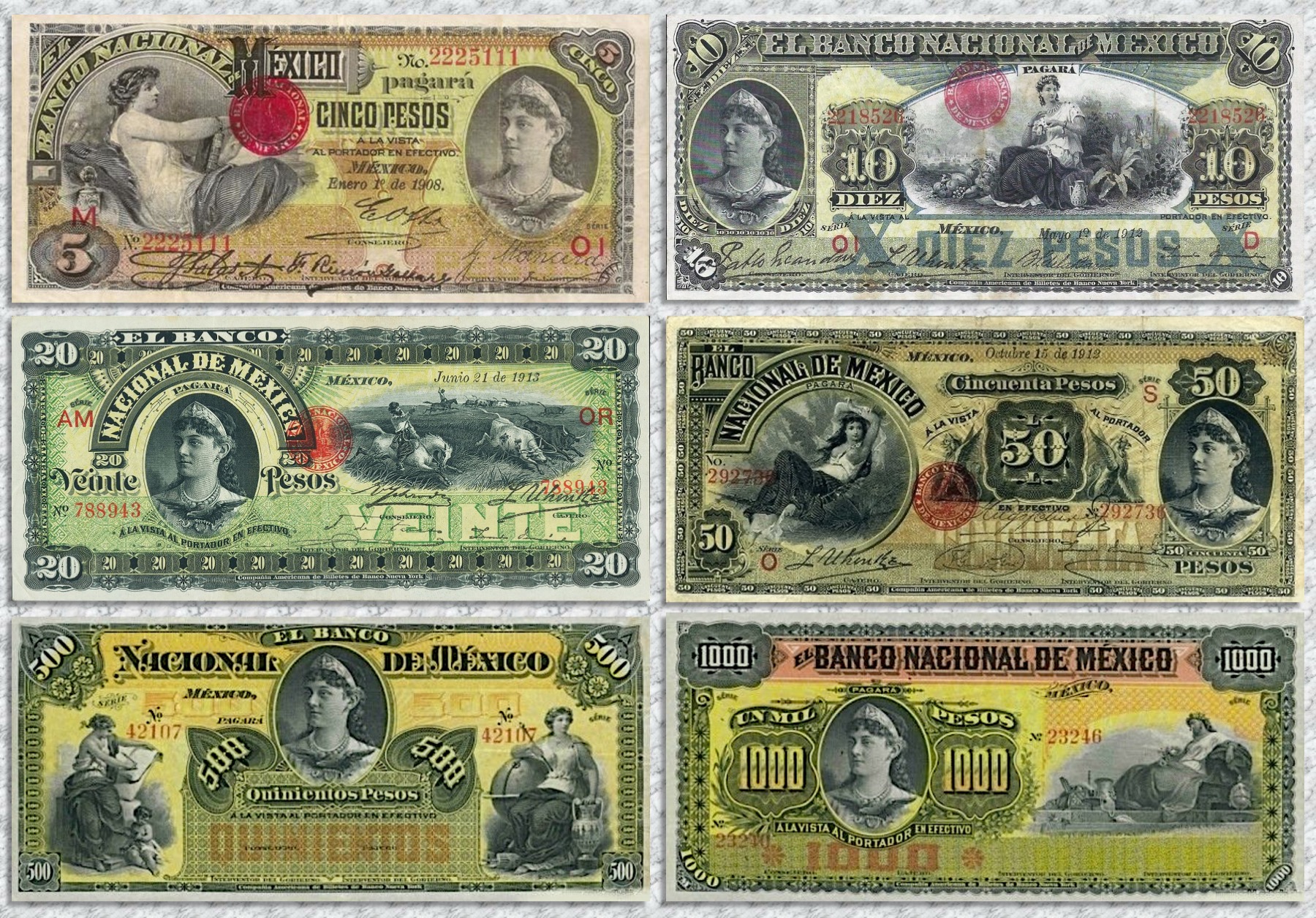
Banknotes issued by the National Bank of Mexico ![]()
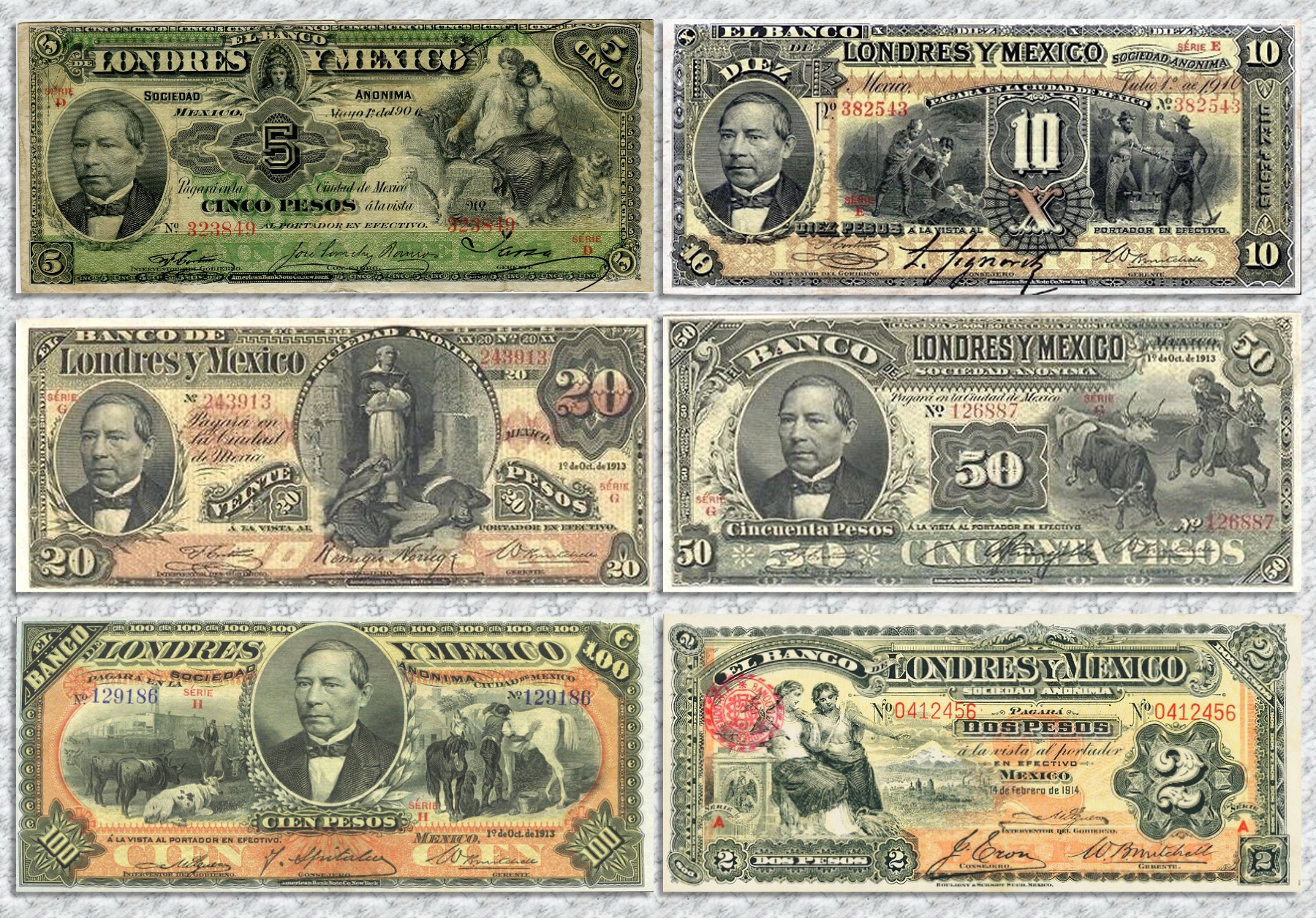
Banknotes issued by the Bank of London and Mexico ![]()
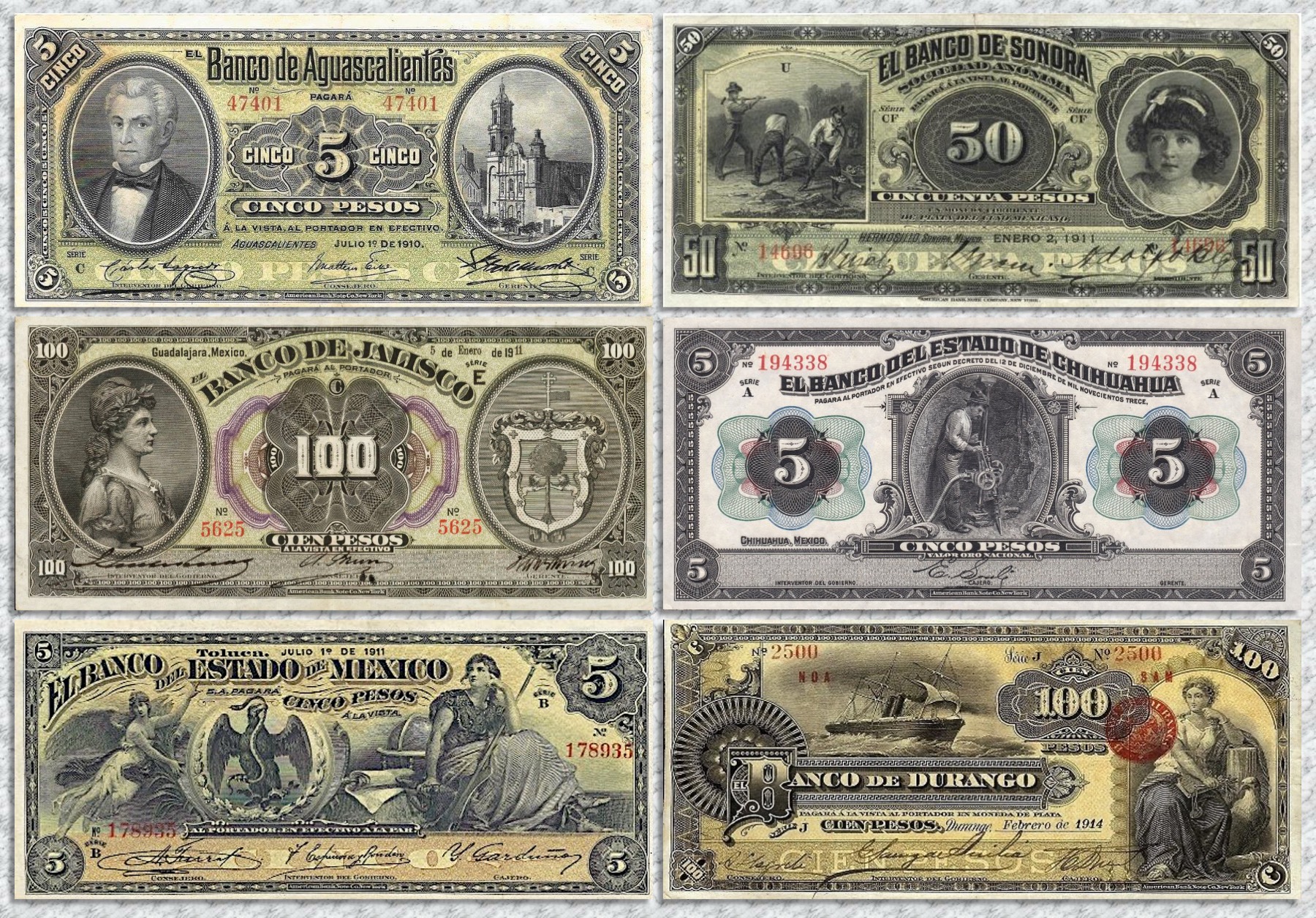
Banknotes issued by different private state banks ![]()
In this way, Mexico adopted the banknote as a widely accepted means of payment. The banknotes of these banks were issued, with the corresponding metal backing, in denominations of 1, 5, 10, 20, 50, 100, 500 and 1000 pesos and were manufactured by specialized foreign companies such as Bradbury, Wilkinson & Company, American Bank Note Company and American Book & Printing Company. Finally, the banknote was accepted by the public.
The Banknote During the 1910 Revolution.
The Revolution against the Porfirio Diaz's government which began in 1910 would lead Mexico once again, to a currency shortage and banknotes discredit. Large amounts of coins were withdrawn from circulation and, besides, banknotes were rejected again.
General Victoriano Huerta -who led a military coup on February, 1913, that overthrew and murdered Francisco I. Madero, Constitutional President of the United Mexican States- ordered the private issuing banks to deliver the banknotes metallic backing to his government and to issue unusually large amounts of banknotes with no backing. Therefore, the painfully built Mexican banking system quickly fell to pieces together with banknotes use and acceptance.
Nevertheless, the lack of currency forced municipal authorities, military leaders and merchants, miners and land owners to issue necessity pieces. As to this, from 1913 to 1915, necessity currency reappeared in Mexico: several metallic pieces were minted nationwide, but the issues of paper money were multiplied. The first to issue this kind of pieces was Venustiano Carranza, First Chief of the Constitutionalist Army and leader of the revolt against Huerta who, in turn, authorized several chiefs to issue their own banknotes, vouchers y and cardboards to collect campaign funds.

Banknotes of the constitutionalist emissions, in charge of Venustiano Carranza and his generals ![]()
The formal characteristics of these banknotes considerably varied; they range from high quality pieces to roughly manufactured notes. The large amount of issues and varieties worsened the Republic's monetary problem rather than solving it. These pieces, which Mexican people called "bilimbiques", had value as far as the issuer had power and authority in a given region. Upon general Huerta's defeat, the situation became more complex with the confrontation among the various revolutionary parties. The "bilimbiques" kept on devaluating their value; furthermore, new issues appeared, such as the pieces of the Mexican Provisional Government issued in Veracruz or those of the Revolutionary Convention of Mexico City. Massive counterfeit of these pieces contributed to worsen the monetary problem in Mexico and to discredit even more paper money.
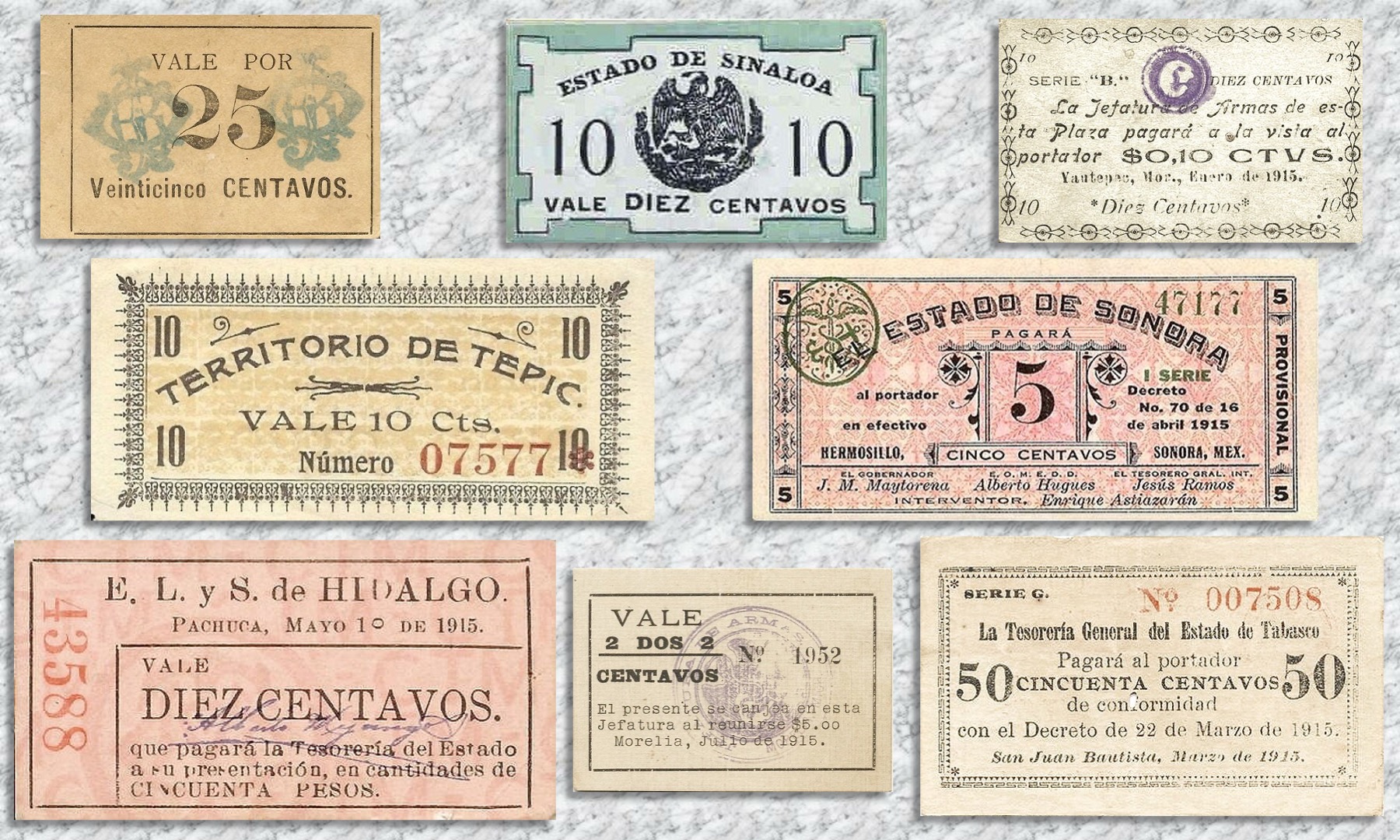
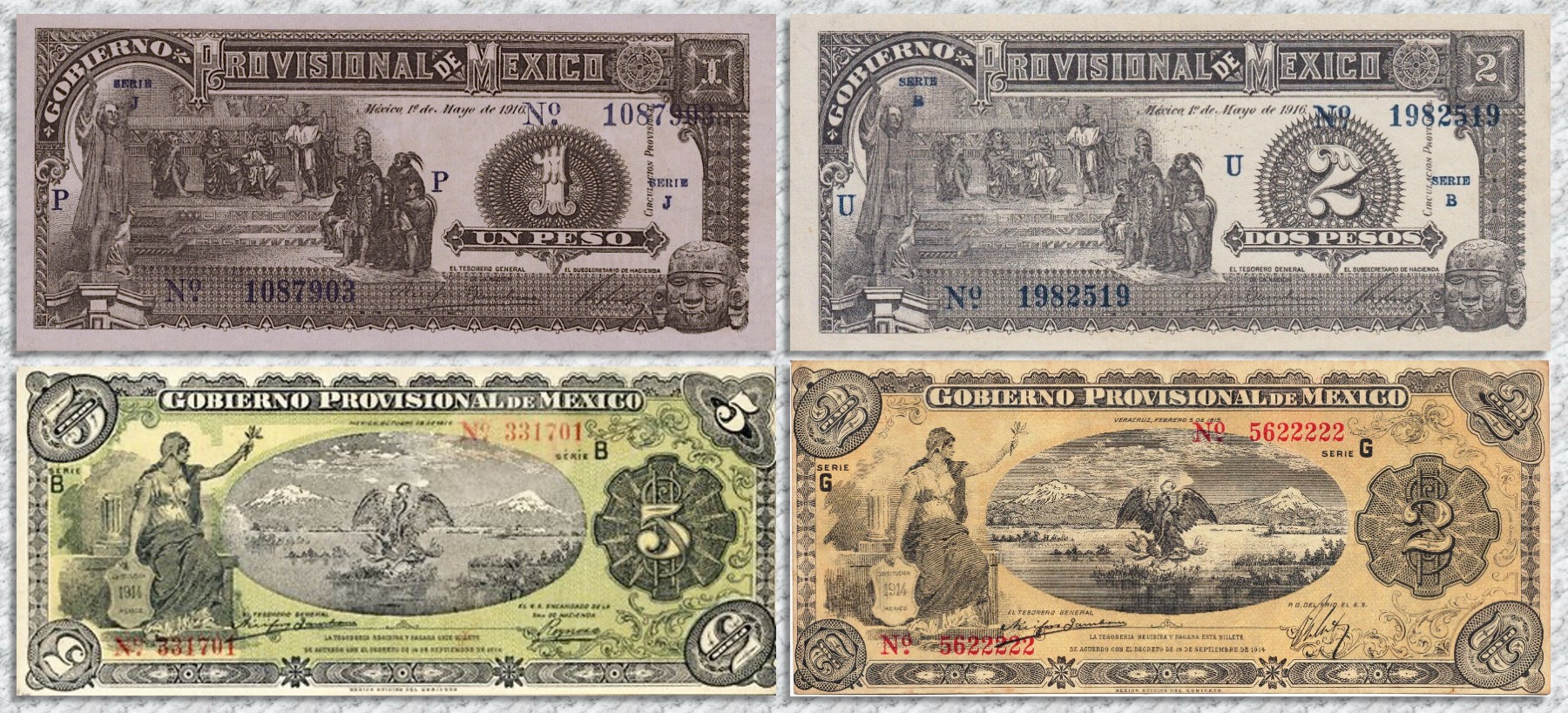
Banknotes issued by the Provisional Government of Mexico ![]()
As the dominion of Carranza's party consolidated, several attempts were made in order to solve the monetary problem in the country: the only valid paper money would be the issued by Carranza and, in order to avoid counterfeits, they issued more sophisticated banknotes manufactured by the American Banknote Company in New York. These banknotes were put into circulation on May 1916, while the former issues were gradually withdrawn. These pieces are known as "forgery proof". Their fate, however, was not different from the revolutionary issues, as they became devaluated and useless at the end of that year. At that period, the only safe currency was the rare and scarce coin, since paper issues were only backed by the force of arms which, in the event of a setback, would left their holders helpless.
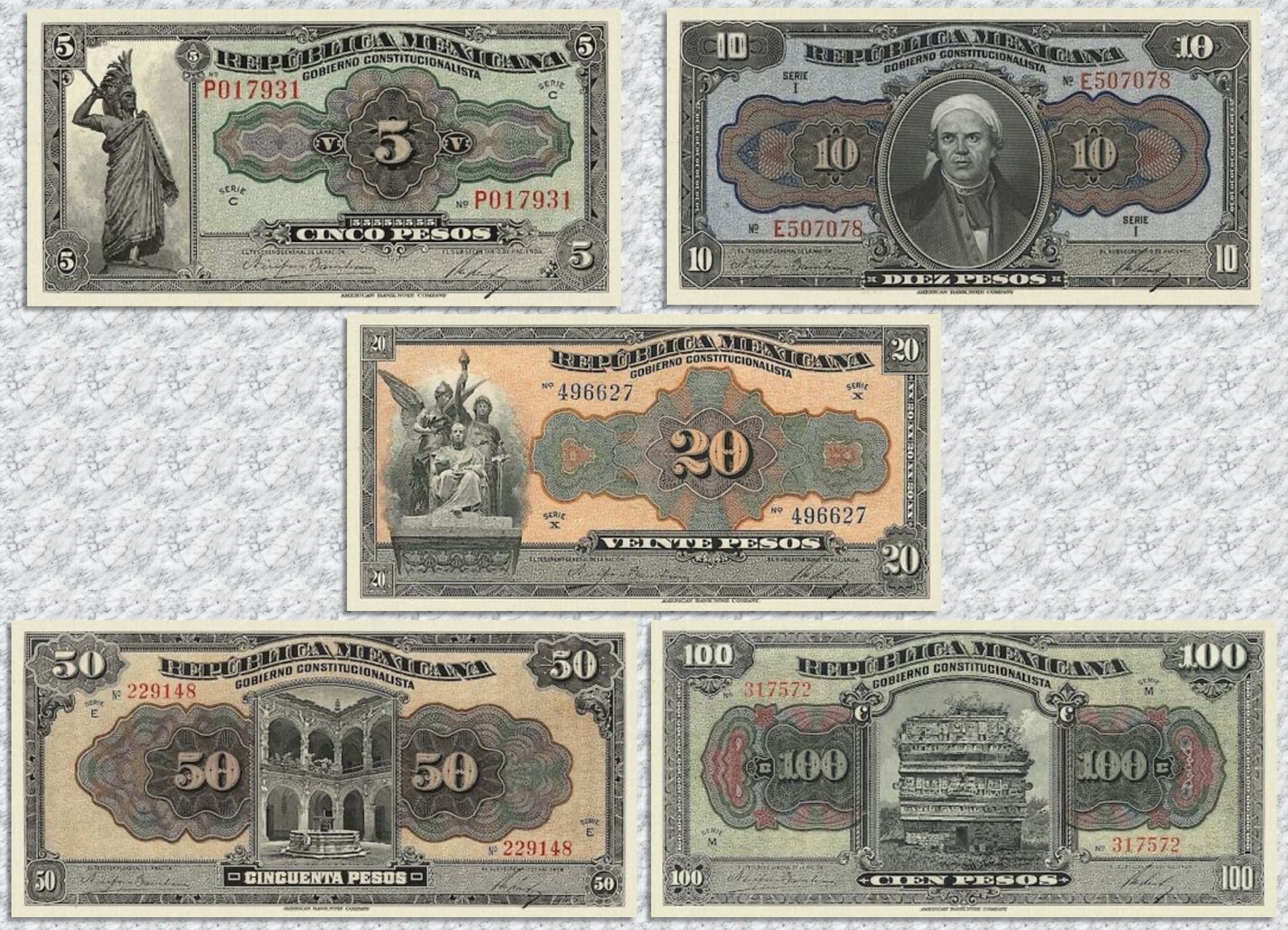
Consequently, late in 1916, Carranza ordered workers to be paid exclusively with coins, whose minting had been restarted at the Mexico Mint. Thus, as Carranza became military strong, there was a glimpse of solution to the monetary problem in Mexico.
The Republic reconstruction posed new problems, like the establishment of a new banking system in the country. The first step towards it was to declare bankruptcy and to liquidate the former porfirian banks; the second, the establishment of a new issuer. In order to restore order to the Mexican economy, the Monetary Commission was created, whose main task was to regulate monetary circulation and address the problems arising from the uncontrolled issuance of revolutionary banknotes. Some banknotes bearing the legend Monetary Commission were already issued by 1920, although they only remained in circulation for a few months.

Banknotes issued by the Monetary Commission ![]()
The Article 28 of the Mexican Political Constitution promulgated on February, 1917, establishes that the monopoly of the issue would belong to a sole Bank under government control.
This bank is the direct precursor of the Bank of Mexico and took eight years to come into being, time to gather the necessary resources, reach an internal political consensus, define its nature and agree on the role of the government. However, in the meantime other projects have been presented aimed at regulating this revolutionary aspiration. The authors of one of them, the Bank of the Mexican Republic, were so convinced of its success that after briefly considering the possibility of printing their notes in Mexico, they decided to ask Canadian manufacturers, the British American Bank Note Co. (BABNC) based in Ottawa, and an American one, the American Bank Note Company (ABNC) of New York, to prepare tests and decided to print the notes in the latter country.
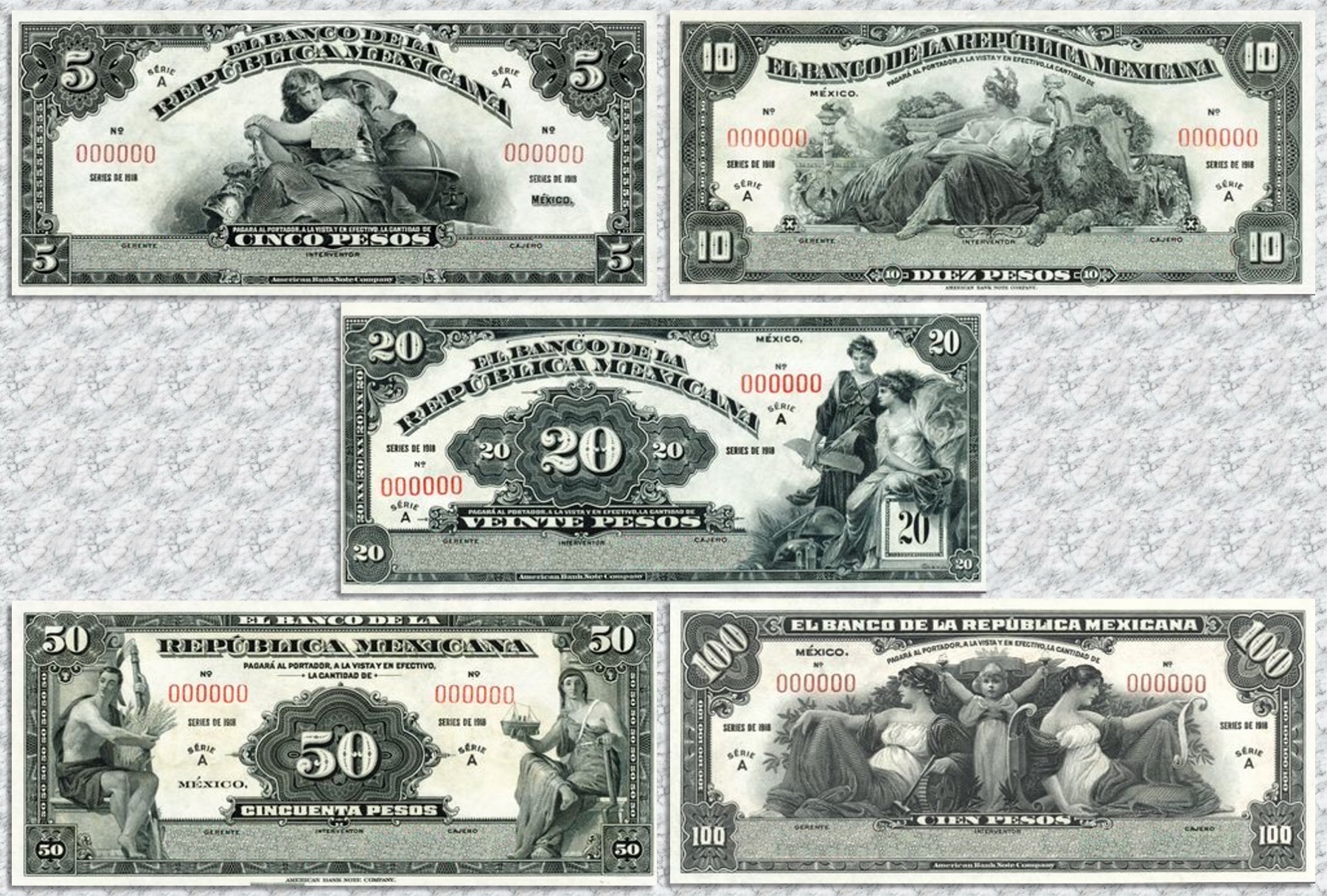
Banknotes issued by the Bank of the Mexican Republic; printed by the American Bank Note Company ![]()
The Bank of Mexico Note.
Banco de Mexico started operations on September 1st, 1925, thanks to the budget and organizational efforts of Plutarco Elias Calles, then President of the Republic. Issuing and regulation of the currency circulation were among the functions of the new Central Bank. The restoration of user's trust in banknotes was one of the major problems Banco de Mexico faced when issued its first paper money pieces, which at first were issued on a voluntary basis in order to gradually restore the use and trust on this exchange medium by the public.
The first Banco de Mexico notes were printed by the American Banknote Company in New York (ABNC), in a 180 x 83 mm. size. This first series consisted of the 5, 10, 20, 50, 100, 500 and 1000 peso banknotes.
First banknotes of the Bank of Mexico; printed by the American Bank Note Company - First Emission
Later, from1936 to 1942, a second transitory series was issued; this series was also printed by the New York firm, but in a smaller size (157 x 67 mm.); the 5 and 10 peso notes maintained the former designs, while in the 50 and 100 pesos new designs were adopted where the figures of our heroes appeared for the first time in the Bank of Mexico issues.
Transition banknotes - Second Emission
First of the Bank of Mexico with images of historical figures for those of 50 and 100 pesos
Concurrently with the second series, a third one was put into circulation (1936-1978), also printed by the ABNC. The issued pieces were of 1, 5, 10, 20, 50, 100, 500, 1000 and 10000 peso denominations. The novelty of this series was the inclusion of the 1 peso note, which is the only one of this denomination that the Bank of Mexico has issued in its entire history.
Third emission of the Bank of Mexico banknotes printed by the American Bank Note Company - Third Emission
A new chapter in the Mexican banknote history begins on 1969, when the Banco de Mexico Printing Works starts operations. Thus, a new generation of Mexican banknotes appeared; these banknotes were manufactured using the latest technological advances and according to designs, iconography and conceptions different from those prevailing at that time. The fourth series (1969 1991), first of national manufacture and known as Type A,, consisted of the 5, 10, 20, 50, 100, 500, 1000, 2000, 5000, 10000, 20000, 50000 and 100000 peso banknotes.
Banknotes of family A, printed by the Bank of Mexico Banknote Factory - Fourth Emission
With the aim of simplifying the handling of domestic currency amounts, under a decree of June 18th, 1991, a new unit of the United Mexican States Monetary System was created, equivalent to one thousand pesos of the former unit; these unit conserved the name "peso". In order to distinguish it from the former monetary unit, for a transitory period the adjective "nuevo" (new) was used before the name "peso". The use of this adjective was omitted starting from January 1st, 1996. During 1992, Banco de Mexico issued a new series of banknotes in 10, 20, 50 and 100 peso denominations with the adjective "nuevo" before the unit's name. These banknotes, known as Type B, maintained the same design of the former notes.
Banknotes of family B - Fifth Emission
At the end of this year, a new series of banknotes was printed, also bearing the name " nuevos pesos", but with new designs. This series consisted of 10, 20, 50, 100, 200 and 500 banknotes; the first three denominations are 129 x 66 mm. and the last three 155 x 66 mm.These notes are known as Type C.
Banknotes of family C - Sixth Emission
This process concluded by eliminating the adjective "nuevo" (new) from the unit's name on the last series of banknotes issued by Banco de Mexico (from 1994 to 2001). This series kept the same designs as the former one, but the term "nuevos" is no longer placed before the word pesos. Banknotes of 10, 20, 50, 100, 200 and 500 pesos with the aforementioned characteristics and are known as Type D.
Banknotes of family D - Seventh Emission
Subsequently, in October 2001, a new issue of banknotes (known as Type D1 Notes) was put into circulation that retains the same designs but incorporates new security features, in addition to the existing ones. This issue was added to the banknotes in circulation in the denominations of 50, 100, 200 and 500 pesos.
Banknotes of family D1 - Seventh Emission
As of September 30, 2002, 20 pesos banknotes printed on polymer instead of paper were put into circulation. Polymer, being a more durable material, was incorporated into these low-denomination banknotes, since they deteriorate the fastest. These banknotes are also produced at the Bank of Mexico Banknote Factory and, in appearance, are similar to paper ones, but have a distinctive security feature: a transparent window.
Banknote of 20 pesos (D1, polymer) - Eighth Emission
On November 15, 2004, the 1000 pesos paper note corresponding to Type D1 was put into circulation, with the purpose of facilitating the public to carry out some cash transactions.
Banknote of 1000 pesos (D1, paper) - Seventh Emission
As of November 2006, the issuance of the Type F banknote family began, which presents changes in the security elements, in the colors and sizes. Each denomination is of a different color so that the public can easily differentiate between them. The notes are of different sizes to help the blind to identify the different denominations; all are 66mm wide and vary in length. The lowest denomination banknote (20 pesos) is the smallest at 120 mm, and the highest (1,000 pesos) is the longest at 155 mm. Between each of the six denominations (20, 50, 100, 200, 500 and 1,000) a difference of 7 mm is maintained. The 20 and 50 peso bills are printed on polymer while the rest are printed on cotton paper.
Banknotes of family F - Ninth Emission
As of May 6, 2013, the Bank of Mexico put into circulation a new 50 pesos note that incorporates new security features made with the most advanced technology and other variants with respect to the F family note of the same denomination. This new banknote, like its predecessor, is printed on a polymer substrate; its predominant color is magenta, it has the same dimensions: 66 mm high by 127 mm long, and it preserves the effigy of José María Morelos y Pavón as the main motif on the obverse. This new banknote belongs to the F1 family because it is a variant of the F banknote.
Banknote of family F1 - Tenth Emission
Within the F family of banknotes there are also single issue banknotes. It is the one hundred pesos note, commemorating the centenary of the beginning of the Mexican Revolution (printed in polymer); of the 200 pesos note, commemorating the bicentennial of the beginning of Mexico's Independence (printed on cotton paper), and of the 100 pesos note commemorating the centenary of the promulgation of the Political Constitution of the United Mexican States of February 5, 1917. These banknotes are legal tender and do not replace the common denominations of 100 and 200 pesos. As commemorative notes deteriorate, they will be withdrawn from circulation. The fact that few pieces have been issued is an invitation to the public to keep them for their excellent design and quality.
Commemorative banknotes of family F - Commemoratives
On August 27, 2018, the 500 pesos banknote of the G family was put into circulation, the first of a new family of banknotes with improvements in its security, functionality and durability characteristics.
The thematic motifs represented in the designs will allude to the historical processes that have defined us as a nation, and for the first time, will emphasize the natural wealth that is distributed throughout the national territory. On the obverse, each denomination will represent one of the following historical processes: Ancient Mexico, the Colony, Independence, the Reform and Restoration of the Republic, the Revolution and Contemporary Mexico. In the reverse, the six most representative ecosystems of our geography will be reflected: rivers and lakes, temperate forests, dry forests, scrublands and deserts, coasts, seas and islands, and humid forests, through sites recognized in the list of the "Heritage World" of the United Nations Educational, Scientific and Cultural Organization (UNESCO). Also on the back of each banknote of the G family there will be an element of fauna and flora identified with each of the six ecosystems.
The banknotes of the G family are 65 mm wide and have a variation of 7 mm in length between one and another consecutive denomination. The 200 pesos note is 139 mm long, the 500 pesos note is 146 mm long, and the 1,000 pesos note is 153 mm long; all three are printed on cotton paper. The 100 pesos note measures 132 mm and the 50 pesos note is 125 mm long; these two are printed on polymer.
Banknotes of family G - Eleventh Emission
Within the G family of banknotes there is also a single issue banknote. It is the 20 pesos banknote commemorating the bicentennial of the Consummation of National Independence (printed in polymer). This banknote is 120 mm long and is legal tender.
Commemorative banknote of family G - Commemoratives